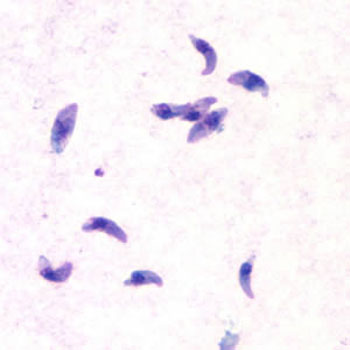New Model Boosts Development of Drugs to Treat Toxoplasmosis
By LabMedica International staff writers
Posted on 26 Jul 2016
A novel model system to facilitate development of drugs to treat toxoplasmosis and other parasitic infections is based on a strain of Toxoplasma gondii that produces cysts in vitro that mimic those found in living animals.Posted on 26 Jul 2016
The Brazilian EGS strain of T. gondii forms cysts in tissue culture that resemble the dormant cystic parasites that live in human and animal brain cells. These cysts highly express the mitochondrial enzyme cytochrome b.

Image: A photomicrograph of Toxoplasma gondii tachyzoites, stained with Giemsa (Photo courtesy of the CDC).
Using the EGS strain model system, an international team comprising 39 researchers from 14 institutions in the United States, United Kingdom, and France envisioned, and then created, novel 4-(1H)-quinolone scaffolds to target the parasite's cytochrome bc1 complex. The lead 5,6,7,8-tetrahydroquinolin-4-one compound, MJM170, was highly effective against toxoplasma parasites and had substantially enhanced solubility compared with other reported quinolones due to the new scaffold.
"This is an immensely useful and important advance for medicine development," said senior author Dr. Rima McLeod, professor of ophthalmology, visual sciences, and pediatrics at the University of Chicago (IL, USA). "It allows us to define its genotype and phenotype in depth and to identify what it does to its human host's blood and primary brain stem cells. Remarkably, this encysted parasite turns on host cell pathways in ways that can alter ribosomal function and cause mis-splicing of transcripts as well as other flaws associated with Alzheimer's and Parkinson's disease."
The compounds developed with the aid of the T. gondii model system were also found to be highly effective against the malaria parasite Plasmodium falciparum.
The paper was published in the July 14, 2016, online edition of the journal Scientific Reports.
Related Links:
University of Chicago













